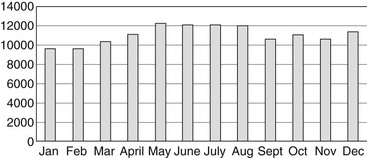Chapter 20 The majority of dog and cat poisonings are accidental, with ingestion of dropped pills the most common scenario. Oral exposures to toxins make up 85.6% of all inquiries. Dermal exposures are next with 6.2%, followed by a combination of dermal/oral with 3.6%. Although exposures are steady throughout the year, the summer months always show an increase in calls (Figure 20-1). This may be due to pets having increased access to the outdoors and its associated toxins (plants, herbicides, insecticides), pets having increased exposure to flea and tick treatments, or children being at home on vacation and possibly not being as vigilant with keeping substances out of a pet’s reach. The 2 weeks around Christmas have a 10% increased call volume, mostly related to chocolate, a popular gift given during a hectic season in which pets may not be as carefully monitored. October, with Halloween, also has an increased call volume related to pets ingesting candy and chocolate.
ASPCA Animal Poison Control Center Toxin Exposures for Pets
< div class='tao-gold-member'>
ASPCA Animal Poison Control Center Toxin Exposures for Pets
Only gold members can continue reading. Log In or Register to continue

Full access? Get Clinical Tree



